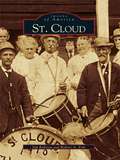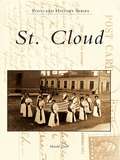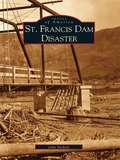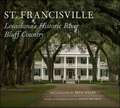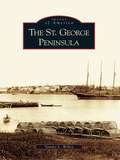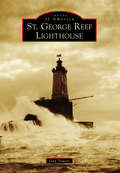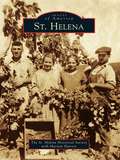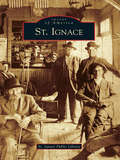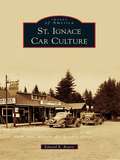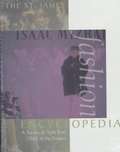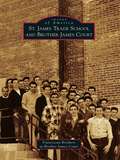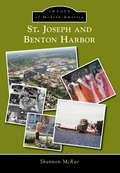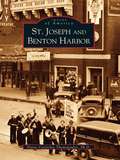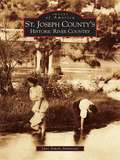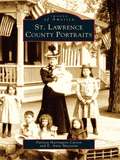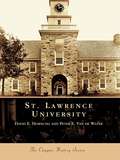- Table View
- List View
St. Cloud (Images of America)
by Robert A. Fisk Jim RobinsonIn the heart of Central Florida lies St. Cloud, an amiable city with a bright future and a colorful past. Located in Osceola County, only a short distance from the Sunshine State's most-visited tourist attractions, the city has benefited greatly from its unique locale. But long before the city attracted sightseers, it was a booming sugar exporter and a haven for retired Civil War veterans. The town, named for a Paris suburb, was incorporated in 1911 as a "soldier's colony" and was touted for its "health, climate, and productiveness of the soil." Today, St. Cloud celebrates its diverse population, ideal location, and agricultural history. Original images, including scenes from the 1917 fire, underscored with informative text abound in Images of America: St. Cloud. Revealed inside is the impact that Hamilton Disston and the many army veterans who settled here had on the city's development. Highlighted in this delightful photo journal are communities such as Alligator Lake, Narcoossee, Runnymeade, and Ashton that are uniquely St. Cloud. Showcased are the diverse people, places, and events that make St. Cloud an enjoyable place to live and visit.
St. Cloud (Postcard History Series)
by Harold ZoselSt. Cloud, located on the Mississippi River and in the center of Minnesota, was incorporated on April 2, 1856, by merging three towns together. Through the magic of vintage postcards, travel through time to early in the last century. Readers can see buildings and street scenes that are long gone or changed so much they are unrecognizable today. Explore the granite industry, here since the early 1860s. Meet Samuel Pandolfo, who decided to build an automobile here in 1917. Learn about the man who developed a tin can chair, as well as the St. Cloud Reformatory, which has the largest wall in the United States.
St Ct #1 War Dragons: The Captain's Table (Star Trek #Bk.1)
by L A GrafThere's a bar called "The Captain's Table," where those who have commanded mighty vessels of every shape and era can meet, relax, and share a friendly drink or two with others of their calling. Sometimes a brawl may break out but it's all in the family, more or less. Just remember, the first round of drinks is always paid for with a story...even beyond the final frontier. Captain James T. Kirk must join forces with Captain Hikaru Sulu, new commander of the U.S.S. Excelsior,to resolve a simmering political situation in a distant star system. For more than twenty years, the ancient enmity between Nykkus and Anjiri has resisted the best efforts of Federation diplomats. Now Kirk and Sulu have one last chance to end the bloodshed -- before it erupts into a full-scale interstellar war!
St Ds9 #21 Trial By Error (Star Trek #21)
by Mark GarlandWhen Quark brokers a lucrative deal to trade trellium crystals from the Gamma Quadrant for gold-pressed latinum, the potential for profit seems too good to be true. It is. Pretty soon, Deep Space Nineis under fire from at least three different alien races, each accusing the others of theft, piracy, and worse. Then, angry Klingons get involved, and so do the Ferengi... Odo wouldn't mind seeing one of Quark's schemes backfire, but not when it places the entire station in the middle of a shooting war that might consume them all!
St Ds9 #22 Vengeance (Star Trek #22)
by Dafydd Ab HughRumors of a secret alliance between the Dominion and the Klingon Empire lure Captain Sisko and the crew of the Defiant on a desperate mission into the Gamma Quadrant, leaving Deep Space None vulnerable to a surprise sneak attack! Now an elite Klingon task force has seized control of the station, and only Chief O'Brient, Dr. Bashir, and Worf are left to defend Deep Space Nine. But Worf's loyalties are tested when he discovers that the invaders include his oldest friend -- and his own brother!
St Ds9 Ferengi Rule Of Acquisition (Star Trek)
by Ira Steven BehrThe Ferengi are greedy, avaricious, ruthless, cowardly and completely unscrupulous. For centuries the famous Ferengi Rules of Acquisition have been the guiding principles of the galaxy's most successful entrepreneurs. These 285 Rules of Acquisition range from, #1 "Once you have their money, never give it back." to #21 "Never place friendship before profit." These rules and hundreds more have taken many successful Ferengi to new frontiers of profit.
St. Francis Dam Disaster
by John NicholsMinutes before midnight on the evening of March 12, 1928, the St. Francis Dam collapsed. The dam's 200-foot concrete wall crumpled, sending billions of gallons of raging flood waters down San Francisquito Canyon, sweeping 54 miles down the Santa Clara River to the sea, and claiming over 450 lives in the disaster. Captured here in over 200 images is a photographic record of the devastation caused by the flood, and the heroic efforts of residents and rescue workers.Built by the City of Los Angeles' Bureau of Water Works and Supply, the failure of the St. Francis Dam on its first filling was the greatest American civil engineering failure of the 20th century. Beginning at dawn on the morning after the disaster, stunned local residents picked up their cameras to record the path of destruction, and professional photographers moved in to take images of the washed-out bridges, destroyed homes and buildings, Red Cross workers giving aid, and the massive clean-up that followed. The event was one of the worst disasters in California's history, second only to the San Francisco Earthquake and Fire.
St. Francis in Italian Painting (Ethical and Religious Classics of East and West #2)
by George KaftalOriginally published in 1950, this book shows that the religious and ethical values that St. Francis was striving after are as essential today as they were in his time. The book presents St. Francis as a complex personality and corrects the rather mawkish interpretation of certain legends. It deals with the environment and development of the saint’s personality and chapters from his biographies by Thomas of Celano or St. Bonaventure and many black and white plates illustrating them which are reproductions of paintings by Italian masters from the XIIIth to the late XVth century.
St. Francisville: Louisiana’s Historic River Bluff Country
by Danny Heitman Bevil KnappIn the rolling hills of Louisiana's Felicianas, less than an hour north of Baton Rouge on the east bank of the Mississippi River, lies the historic community of St. Francisville. For generations, this picturesque town has inspired a variety of creative artists, from naturalist John James Audubon, whose experiences in the area helped make him the world's greatest bird artist, to acclaimed novelist Katherine Anne Porter, who wrote one of her best travelogues, "Audubon's Happy Land," in 1939 after a visit to St. Francisville. Award-winning photographer Bevil Knapp embraces this lively tradition by lending her own perspective on a region Audubon once praised as an expression of "the greatness of the Creator in all his unrivaled works."Vividly evoking St. Francisville's fabled past as plantation country, Knapp offers stunning views of the stately historic homes that draw thousands of tourists annually -- including Oakley, Live Oak, Rosebank, Rosedown, and The Myrtles, among many others. But Knapp's images are more than mere architectural studies; they artfully invite the viewer to ponder who lived behind the windows of these historic homes -- and who might live there still. Knapp also captures the area's unmatched natural bounty, documenting the woods, waterways, and wildlife of a region that, in many ways, has remained unchanged for centuries. In addition to honoring St. Francisville's strong links to the past, Knapp's photographs reveal the town's continuing vitality as a respite from urban life. St. Ferdinand Street, a vibrant collage of small-town southern life; Afton Villa Baptist Church, a thriving African American congregation founded in 1871; Tunica Hills, a popular hiking destination named for the Tunica Indians who lived in the area for centuries; the nearby Port Hudson Civil War battlefield, site of thrilling annual reenactments -- all reveal their singular charm through Knapp's knowing lens. In an introductory essay, acclaimed journalist and author Danny Heitman offers a poetic counterpoint to Knapp's imagery, reflecting on photographs that, for all their historical resonance, "hum with the immediacy of news."Ultimately, Knapp's images transcend time, illuminating a flourishing community of unrivaled natural and historical beauty. A cherished memento for locals and visitors alike, St. Francisville summons readers to discover the rich treasures of this wondrous region for themselves.
St. Francisville and West Feliciana Parish
by Anne Butler Norman FerachiSituated where the rugged Tunica Hills skirt the Mississippi River, St. Francisville began as part of Spanish West Florida in the early 1800s. The first settlers were adventurous Anglos who rebelled against Spain, established a short-lived independent republic, stopped the Civil War to bury a Union officer, and planted vast acres of indigo, cotton, and cane. In the 1900s, St. Francisville became the cultural and commercial center of the surrounding plantation country. Today, overlooking the river from atop a high, narrow ridge "two miles long and two yards wide," it remains the West Feliciana parish seat. Tourists visit its picturesque downtown, a lively Main Street Community and National Register Historic District. Antebellum plantations and gardens draw tourists year-round, and the unique hilly terrain provides unsurpassed recreational opportunities for hiking, bicycling, birding, hunting, and nature studies. Ever since John James Audubon painted dozens of his birds in West Feliciana in 1821, artists, writers, and other visitors have found inspiration in this scenic, unspoiled spot.
St. George Peninsula, The
by Tammy L. WilleyThis fascinating history captures more than two centuries of life on and around the St. George Peninsula. These images feature war heroes, churches, community volunteers, historic sites, summer visitors, sailing vessels, and all phases of the still important fishing industry. St. George's rich cultural heritage is well documented due to the booming granite industry, which lured European laborers to this area in the early 20th century. Many of these quarryworkers remained. They put down roots and constructed stores, post offices, schools, and clusters of wood-framed dwellings. The stark walls of abandoned granite quarries still pay tribute to these hardworking immigrants. Today, this area is the gateway to Monhegan Island. It inspires theexceptional Wyeth paintings and is a magnet for other noted artists and photographers. Locals, however, still cling to the traditions of their small seaside town.
St. George Reef Lighthouse
by Guy TowersSituated at the end of a reef six miles offshore of Crescent City, California, stands St. George Reef Lighthouse. Constructed after the wreck of the coastal steamer Brother Jonathan in 1865, the beacon warned mariners of the dreaded "Dragon Rocks" of St. George Reef for nearly a century. This book chronicles the loss of the Jonathan, decades of efforts to make the light a reality, the 10-year construction period, manning of the station by keepers of the US Lighthouse Service and Coast Guard, and the struggles and accomplishments of dedicated volunteers to restore what many lighthouse historians refer to as "America's greatest lighthouse."
St. Helena
by The St. Helena Historical Society with Mariam HansThe town of St. Helena lies in the heart of Napa Valley, America's celebrated wine-producing region located 63 miles north of San Francisco. In 1854, Henry Still and a Mr. Walters purchased 126 acres from the Mexican land grant of Dr. Edward Bale. They offered free lots to anyone who would start a business there, having the foresight to predict a flourishing town in this verdant agricultural area. Premium wine grapes were planted here by the 1870s, and a thriving wine industry began. There are two theories about how the town got its name: either from the local division of the Sons of Temperance or from Mount St. Helena at the northern end of the valley. As the town developed, its residents, along with those from nearby Oakville, Rutherford, Angwin, and Pope Valley, shopped at its stores, attended its churches and schools, tended its fields, and made merry at numerous gatherings. This book captures these activities in photographs dating from 1880 to 1960.
St. Helens (Images of America)
by Tricia Brown Columbia County Museum AssociationRight from its start in 1847, this little town along the Columbia River was built with calloused hands. In these pages, one will see the loggers, shipbuilders, quarrymen, and mill workers. Their wives, mothers, and children are here, too, softening the edges and nourishing a community in the woods. Those early settlers built St. Helens to last, and through decades of booms and busts, tragedies and triumphs, the people's love for this place, so rich in beauty and possibility, shows in more than 200 images. It is a record of endurance, yes, but also of hope.
St. Ignace
by St. Ignace Public LibraryEven before it was named in 1671, St. Ignace was a key part of Michigan history. Before Fr. Jacques Marquette and the Jesuits arrived in the Straits of Mackinac, St. Ignace had a large Native American settlement. With the arrival of the French, fur trading became an important industry. St. Ignace became the county seat in 1882. By the mid-1800s, fishing, shipping, manufacturing, and lumbering were a crucial part of St. Ignace activity. As these industries died down, tourism increased. The area was appealing to tourists for its natural beauty and its fresh air; many came for relief from hay fever and asthma. Initially travelers arrived by ship and train. Ferryboats were important in transporting visitors and goods because of the primitive road system. With its natural harbor, St. Ignace was within easy reach of other Great Lakes ports. With the completion of the Mackinac Bridge in 1957, travel to St. Ignace became much easier. St. Ignace is often referred to as the "Gateway to the Upper Peninsula."
St. Ignace Car Culture (Images of America)
by Ed ReavieSt. Ignace hosted its first car show in 1976 as part of the bicentennial celebration. Over the years, the annual gathering has grown into one of the largest collector-vehicle events in the country. This lakeside community overlooking the mighty Mackinac Bridge and historic Mackinac Island boasts a spectacular waterfront--the perfect backdrop for a stunning array of eye-catching vehicles. In the early years, media referred to this show as "dessert." As the numbers of participants and attendees grew, it became known as the "main course." For teenagers growing up in the 1950s it was all new--cruisin', drive-ins, drag strips, the country's intense love affair with the automobile, and the birth of rock 'n roll. Over 34 years, the St. Ignace Car Show has brought hundreds of automotive legends to town, and car-show traffic set crossing records on the Mackinac Bridge that are unlikely ever to be broken. So fire up the hot rod and cruise back to a simpler time . . . all these cars and still no traffic light!
St Invasion: Book #3 Time's Enemy (Star Trek #16)
by L A GrafThe Federation is threatened by this ancient mystery when a battered and broken version of the Defiantis found, frozen for five thousand years, in an icy cloud of cometary debris. Captain Sisko and the crew of Deep Space NineTMare summoned to answer the most baffling question of their lives: how and when will their ship be catapulted back through time to its destruction? And does its ancient death mean that one of the combatants in a primordial battle is poised now to storm the Alpha Quadrant? Only the wormhole holds the answer -- and the future of the Federation itself may depend on the secrets it conceals.
The St. James Fashion Encyclopedia: A Survey of Style from 1945 to the Present
by Richard MartinThe St. James Fashion Encyclopedia is a collection of well-organized and information-intensive essays (complete with biographical facts) on more than 200 designers, providing a more reliable critical measure and a larger perspective than previously available.
St. James Trade School and Brother James Court
by Franciscan Brothers at Brother James CourtHelping orphaned and disadvantaged boys get a chance at a better life was the mission of Brother James, founder of the Franciscan Brothers of the Holy Cross, a German Catholic Order that sent Brothers to the United States in 1924. To that end, St. James Trade School was established in Springfield, Illinois, in 1928. Two years later, the first group of apprentices was admitted; they and hundreds who followed them through 1972 went on to become certified mechanics, carpenters, and electricians among other valuable trades. High school diplomas were earned beginning in 1948. In 1975, Brother James Court (BJC) opened with a brand new building specifically designed as a residential intermediate care facility. BJC provides both residency and advocacy for developmentally disabled men. Providing the highest quality care, consistent with the spirit and principles of the Franciscan Brothers of the Holy Cross, programs at BJC meet residents' needs and allow them to live happily at BJC for as long as they need.
St. Joseph and Benton Harbor
by Shannon McraeSt. Joseph and Benton Harbor portrays twin cities with very different personalities weathering a time of great change. Long established as thriving centers of manufacturing, fruit farming, shipping, and tourism, both towns faced the enormous economic and cultural transformations of post-World War II America: rapid demographic shifts, urban renewal, social unrest, and the collapse of industrial manufacturing. Through hard work, creative effort, and above all community cooperation, each southwest Michigan town reinvented itself, emerging into the 21st century revitalized and transformed.
St. Joseph and Benton Harbor
by Elaine Cotsirilos ThomopoulosTwo distinct communities which share equally vibrant histories, the twin cities of St. Joseph and Benton Harbor possess a rich heritage rooted in agriculture, manufacturing, transportation, and tourism. Through more than 200 photographs, this book documents the cities' development from the time when pioneers first struggled to create a community in the wilderness. It pays tribute to the men and women who labored to establish farms and industries, and celebrates the delightful beaches and amusement parks-such as the House of David and Silver Beach-that have brought joy to generations of residents and visitors alike.
St. Joseph County's Historic River Country
by Jane Simon AmmesonRiver Country is the name given to St. Joseph County, Michigan, an area of historic small towns including Three Rivers, Mendon, Centreville, Constantine, Sturgis, and Nottawa. Home to one of the largest Amish populations in the state, it is a place of meandering roads often frequented by horse-driven black buggies. The county's towns, many of which are on the Michigan and National Registers of Historic Places, feature architecture that harkens back to the 1800s with styles ranging from Italianate and Greek Revival to Queen Anne and Colonial. This book chronicles River Country's historic development, with insight into the businesses, personalities, activities, and architecture that have contributed to its remarkable charm and character.
St Klingon Dictionary: More Than 400 New And Exciting Recipes All Made With 4 Or Fewer Ingredients And All Gluten-free! (Star Trek #Pt. 1)
by Star TrekThe Klingon Dictionary is the first comprehensive sourcebook for Klingon language and syntax, including fundamental rules of grammar as well as words and expressions that illustrate the complex nature of Klingon culture. It features a precise pronunciation guide, rules for proper use of affixes and suffixes, and a small phrasebook with Klingon translations for essential expressions such as ""Activate the transport beam,"" ""Always trust your instincts,"" and the ever-popular ""Surrender or die!""
St. Lawrence County Portraits
by Patricia Harrington Carson E. Anne MazzottaSt. Lawrence County Portraits is a tribute to the citizens who shaped New York State's largest county. St. Lawrence is a county with many natural attributes: immense forests, navigable rivers, and vast tracts of fertile land. All of these have been instrumental in drawing people to the area. Reflected in St. Lawrence County Portraits are the influences of a strong mix of residents, including the Mohawks, who have called this area home for thousands of years, the European settlers, and those who trace their family history to Canada, just across the mighty St. Lawrence River.
St. Lawrence University (Campus History)
by David E. Hornung Peter E. Van De WaterFounded in 1856, St. Lawrence University is the oldest continuously coeducational institution of higher learning in New York State. Today, it offers a four-year undergraduate program of study in the liberal arts and enrolls approximately 2,000 students. St. Lawrence University looks back at a history that includes industry pioneers, government leaders, a law school, Madame Curie, the SS St. Lawrence Victory, movie stars, and sports legends. Originally chartered as a Universalist seminary and college of letters and science, St. Lawrence championed progressive ideas such as critical thinking and gender equality. The university of the late 19th century, although austere, offered nonacademic activities, including sports teams, a student government, the first Greek-letter organizations, and organizations for music, drama, social activism, and the literary arts. After weathering the Great Depression and World War II, the university grew dramatically; the four-building campus serving some 300 students in the early 1940s became a 30-building campus within 25 years.
